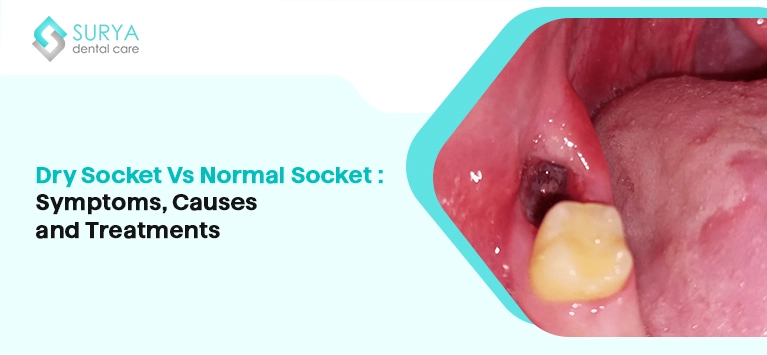Most people fear removing wisdom teeth due to dry sockets (alveolar osteitis), a painful dental condition that affects mandibular teeth(lower jaw) more than maxillary teeth(Upper jaw). Dry socket is most common in wisdom teeth removal, where it has a 30% chance of occurring after other tooth extraction. We have listed the potential causes, symptoms, and treatment options for dry socket that can eliminate your fear.
What is a Dry Socket?
Normally, when the tooth is extracted, a blood clot forms to protect the underlying nerves and bones. In some cases of wisdom tooth removal, however, the blood clot dissolves, exposing the bones and nerves to air, foods, and fluids, causing a dry socket.
dry socket vs Normal socket
| Dry Socket | Normal Socket |
|
Painful condition that can occur after tooth extraction |
Expected normal healing process after tooth extraction |
| Caused by the blood clot dislodging or failing to form properly | Blood clots form and remain in place to protect the bone and nerves |
| This leads to exposed bone and nerve endings, resulting in severe pain | The healing process involves the gradual closure of the socket, with new tissue forming over the extraction site |
| Change in taste | No change in taste |
| It causes bad breath (halitosis) |
No change in how the breath smells |
Symptoms of Dry Socket
After tooth extraction, most people will have a healthy socket that looks like a dark-coloured scab due to a blood clot. This blood clot prevents infections. The pain starts to reduce as the normal socket starts to heal.
Meanwhile, in a dry socket, there will be no blood clot. The pain increases and gets worse as there will be no blood clot to prevent infections.
The main symptoms of dry socket,
- Pain spreads from the socket to the jaw, ear and eye of the same affected side.
- Pain continues to increase
- Exposure of bone and nerve to air, fluid and food
- Bad breath (halitosis)
- Bad taste
- Delayed healing compared to routine post-extraction healing
Causes of Dry Socket
- Poor Oral Hygiene: Inadequate oral hygiene practices can lead to bacterial infections in the socket, preventing proper healing.
- Smoking & Tobacco: cigars or chewing any of these tobacco and fast inhaling of cigarette smoke can make your blot clot dislodged and cause dry socket.
- Trauma(too much pressure on the wound): Excessive physical activity or rough handling of the extraction site can dislodge the blood clot.
- Pre-existing Conditions: Certain medical conditions like poor circulation or immune disorders may increase the risk of dry socket.
- Intake of liquids too fast: Using a straw can make liquid flow faster into your mouth, dislodging the clot.
When you discover you have a dry socket with the symptoms mentioned above, you should consult with a dentist to avoid infections that can make it worse.
Diagnosis and Treatment for Dry socket
The primary treatment for dry sockets is pain management. If there is no pain or little pain, then no treatment is needed. The situation where you face pain is due to bacteria that affect your dry socket, causing bad breath and bad taste.
- The dentist will remove the bacteria from the affected area with salt water.
- The dressing is done on the affected area to make the blot clot and start the healing process>
- Regular dental visits for 2-3 days are needed for proper cleaning and dressing to remove it when the blot clot forms.
- During this procedure, dentists may recommend over-the-counter painkillers to reduce your pain.
- The dry socket starts healing once the blood clot forms, and the pain decreases gradually.
Dry Socket Medications
Dry sockets do not require any specific medication. Dentists treat dry sockets using painkillers. Based on patients’ pain, the dentist prescribes over-the-counter painkillers such as ibuprofen and acetaminophen to reduce pain and fasten the healing process.
If you are not in pain, dentists do not prescribe any medication other than mouthwash to prevent infections caused by dry sockets.
Dry Socket: How Long Does It Last
A dry socket can last up to 7 days when you visit the dentist and undergo treatment for a dry socket. While dressing and mouthwash can keep you away from bacteria, without proper diagnosis, food particles can enter a dry socket to make your condition worse, causing pain and taking time to heal.
Takeaway
If you are experiencing severe pain after tooth extraction, you need to consult with the dentist, as you may be affected by a dry socket. A dry socket can not worsen and cause infection when you follow the diagnosis and treatment process. Untreated dry socket takes time to heal and makes your pain last long.



